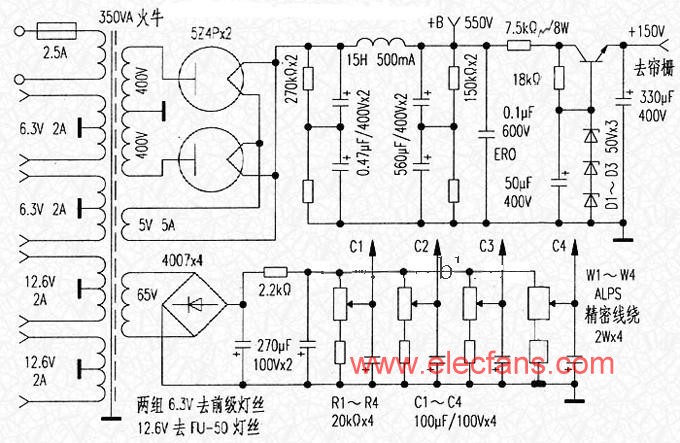The voltage amplification of this machine is composed of 6N2T classic SRPP single-ended parallel push-pull circuit. The dynamic range of the SRPP circuit is large, and the sound quality tends to be acoustic. It is more suitable for use in push-pull amplifier circuits. Since the cathode potential of the tube on this circuit is high, a positive voltage needs to be introduced from the high-voltage end to access the filament end to increase the filament potential to prevent damage to the tube. Of course, if you use 6N11, ECC88 tube, you can ignore this problem, and the sound will have better performance.
Tube selection is very important. Some of the expensive guts are prohibitive. We are in a big country of tube production. Among the many bile ducts, there are some beautiful and cost-effective gall bladders. Fu-50 is one of the best. This tube is a side-heated beam-emitting pentode. It was mainly used in communication equipment for high-frequency oscillation or RF power amplification. It is called a small 300. The music of the push-pull machine assembled with this tube is better than 6P3P, KT88 and other tubes, and the output power can easily be more than 50W. Its high frequency is delicate and vivid, and the low frequency is fierce and strong, and it can also calmly deal with the general three-frequency inverter.

The push-pull and invert phase consists of a low-u tube 6N6T to form a cathode split-phase circuit. The internal resistance of this tube is low, and the driving force is better than the popular special tube 6N8P. In the push-pull amplifier I made, there are only two phase inversion methods, one is the more commonly used long tail phase inversion, and the other is a common cathode phase inversion circuit. In the case of amateur production without special equipment, it is extremely difficult to adjust the positive and negative half-cycle amplitude of the output of the inverting stage to perfect, but the common cathode split-phase circuit can easily obtain a pair of extremely close amplitudes. Positive and negative signals. This level of succession is crucial. Later adjustments need to be repeated and meticulous to make the amplifier work in a state of low distortion and high efficiency.
Amplifier level: FU-50 grid negative pressure is fixed supply type, all components of the negative pressure plate are mounted on a 10cm × 10cm universal board, and the negative pressure adjustment potentiometer must use high-quality products. If W is open or other defects occur The situation will surely cause a sudden increase in the screen flow of the power amplifier tube and burn it. This machine uses 4 ALPS precision wire wound potentiometers to ensure the safety of the machine. In this DIY, the output transformer is the mail-ordered Sichuan Guanghan "Kaili" finished cattle, the 350VA fire cattle is self-made, and the whole machine cost is controlled at about 700 yuan. 
Commissioning: do not insert the tube first, then measure the main voltage, curtain grid voltage, negative bias voltage and filament voltage in the machine after the power is turned on. At this time, the power supply in the machine can be regarded as a no-load state, so the voltage may be higher than the normal value About 10% to 20% is normal. Adjust the negative bias voltage to a maximum value of about 85v, turn off the power and insert each tube one after another without abnormal conditions, mainly adjust the inverting stage and power output stage, use the CD player to play the violin "Liang Zhu", and debug the inversion with the final climax of the movement Level output music level, repeating the music piece in it. When playing the violin solo, the frequency of the mid-band is mostly from 1kHz to 4.5kHz, which is more suitable for adjusting the output voltage of the inverting stage. The voltage between the positive and negative signals and the ground is measured with a digital multimeter AC 100V block. Under the condition of determining the screen voltage and the cathode resistance value, the power tube finely adjusts 4 grid negative piezoelectric potentiometers W, so that the cathode voltage drop of the 4 power amplifier tubes to the ground is 0.5V, and the working point is the midpoint of the screen flow characteristic curve at this time. The position on the negative side is the AB1 type amplification type. The machine must adjust the voltage of each point at least 3 times within a week, and then it can be put into normal use.
Connection test: The sound source is the Japanese "Alpine" rear six-disc CD player + homemade 6N4T + 6N3J pre-level + FU-50 push-pull amplifier + 8-inch two-frequency "dedicated" bookshelf box. , Its extraordinary timbre completely achieved the expected effect.
FGI`s FGSVG series low voltage dynamic reactive power compensation and harmonic devices are mainly composed of control panels, energy storage capacitors, reactors, IGBT, inverters, fuses and other devices. The Low Voltage Static Synchronous Compensator (STATCOM) has functions such as compensating reactive power, controlling harmonics, balancing negative sequence current and suppressing voltage flicker.
Low Voltage Static Synchronous Compensator
Svc Static Var Compensator,Low Voltage Synchronous Compensator,Low Voltage Static Compensator,Low Voltage Static Synchronous Compensator,Statcom Manufacturers,Power Quality Products
FGI SCIENCE AND TECHNOLOGY CO., LTD , https://www.fgi-tech.com
